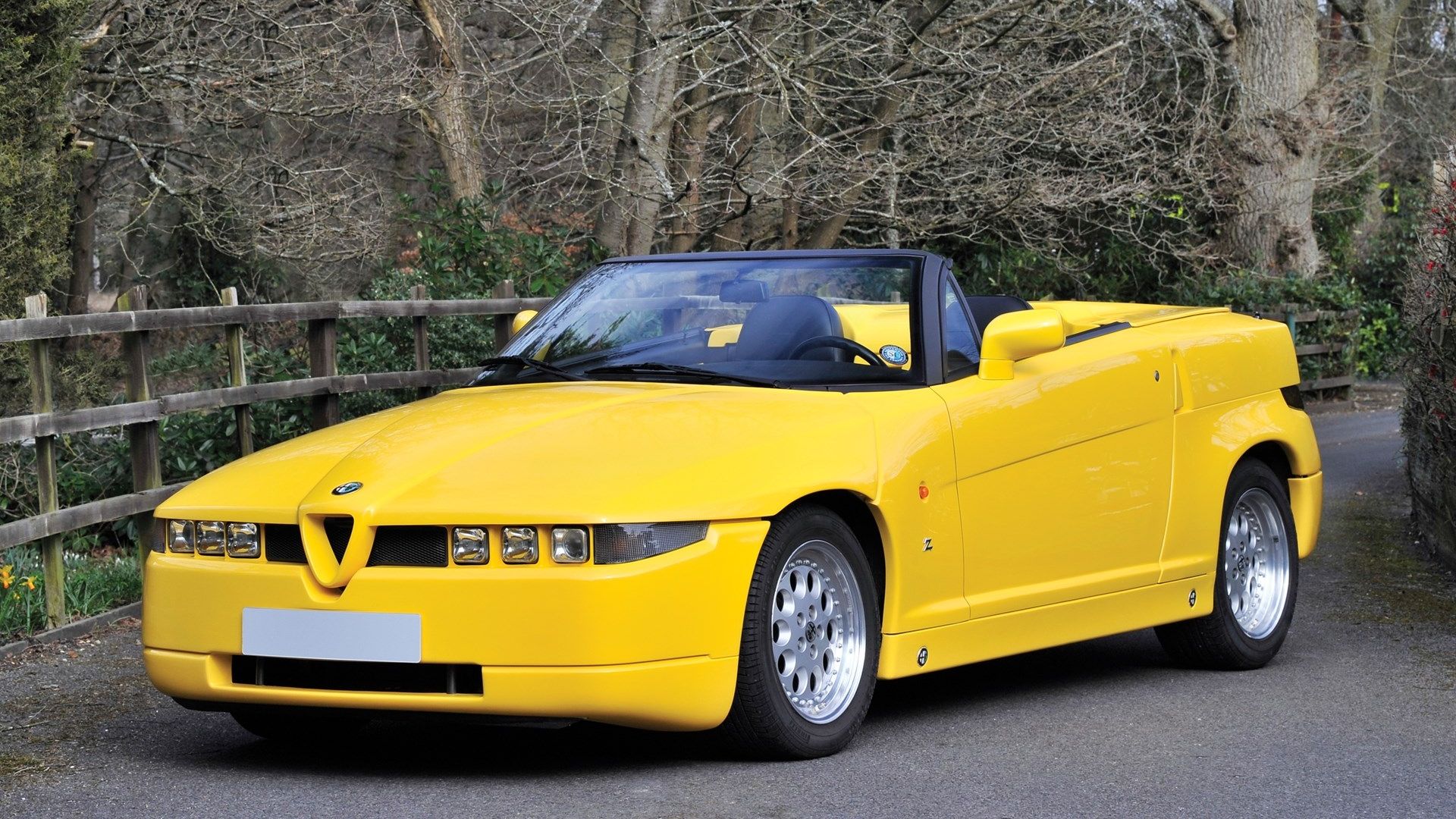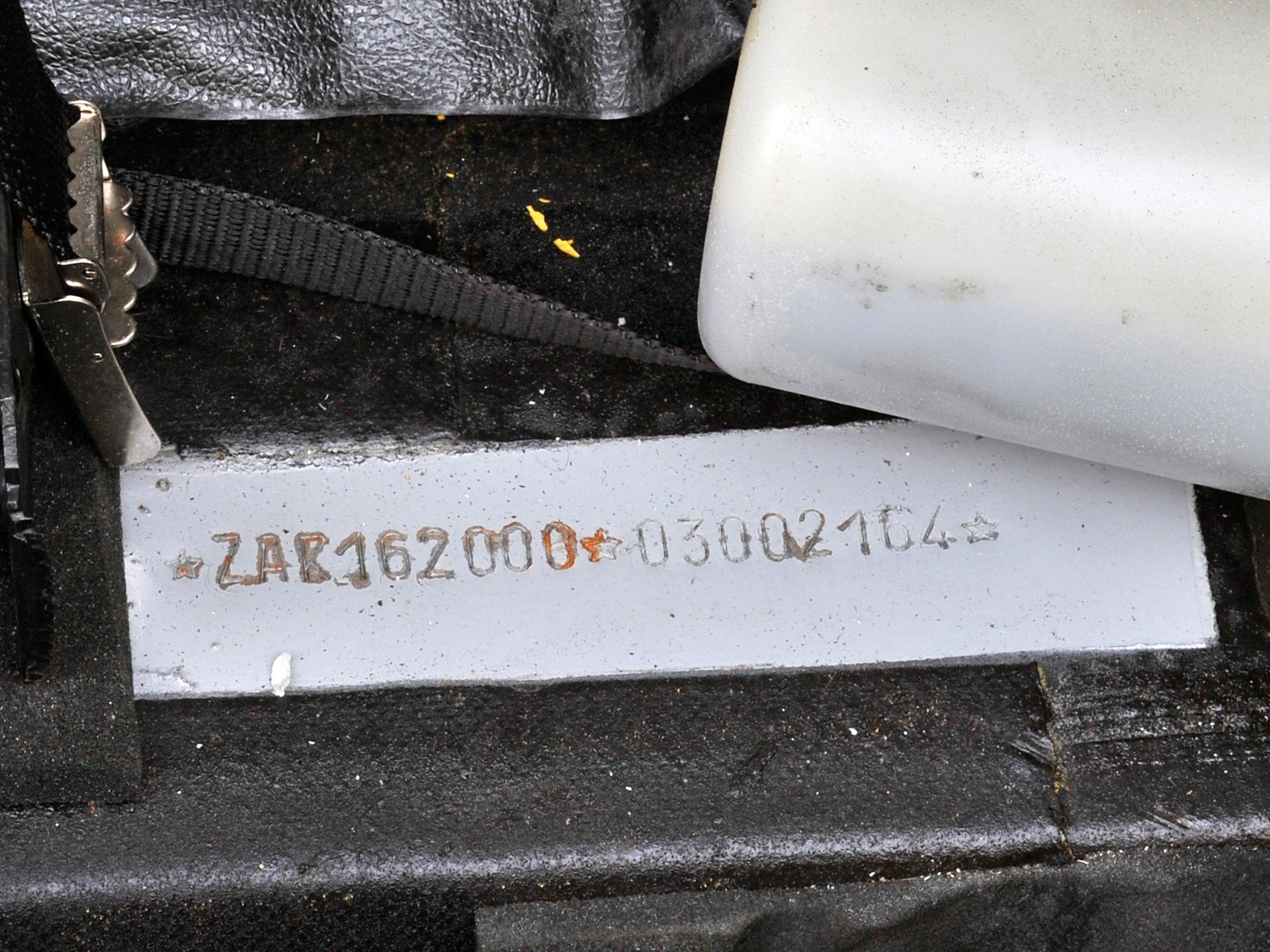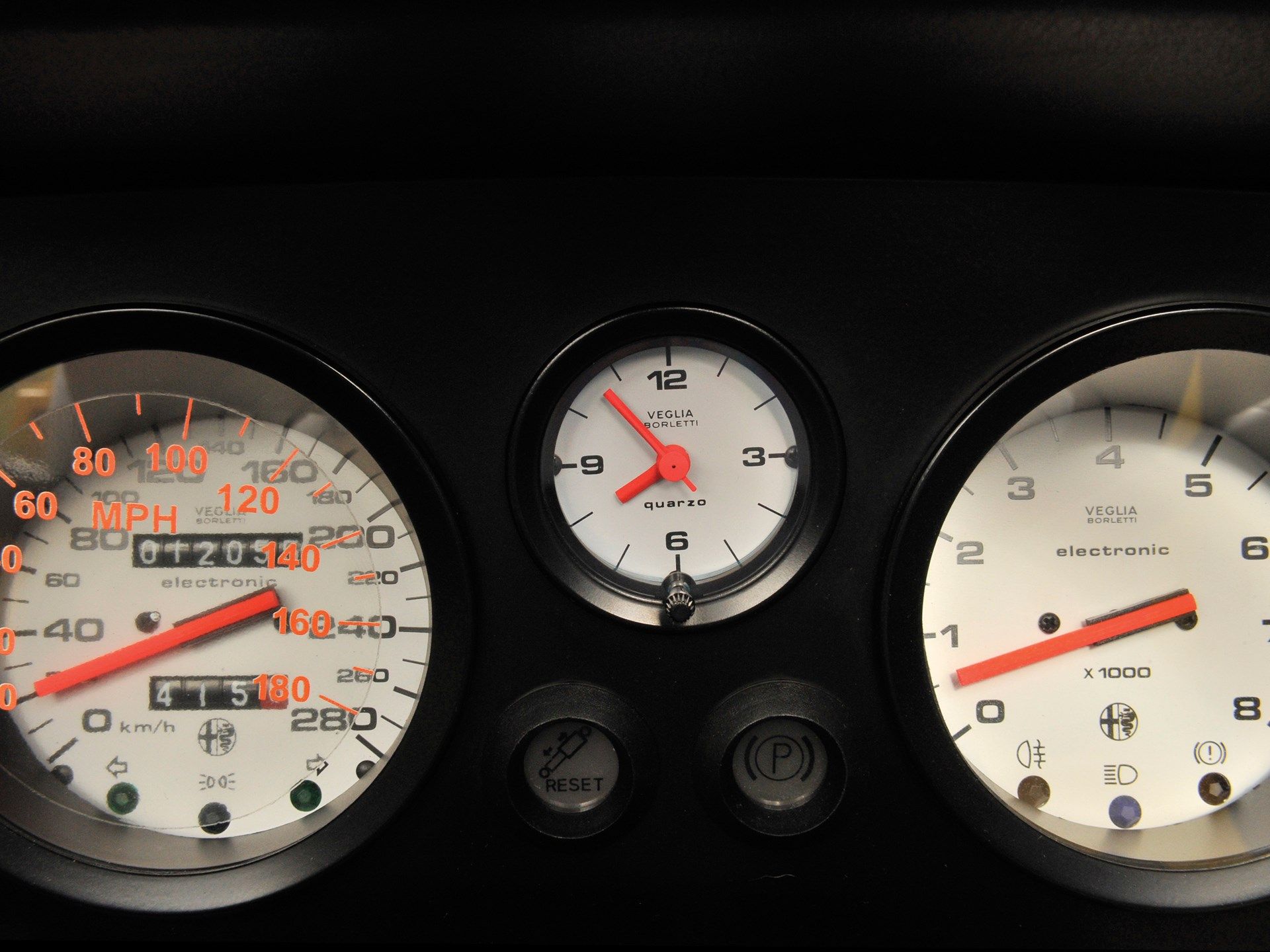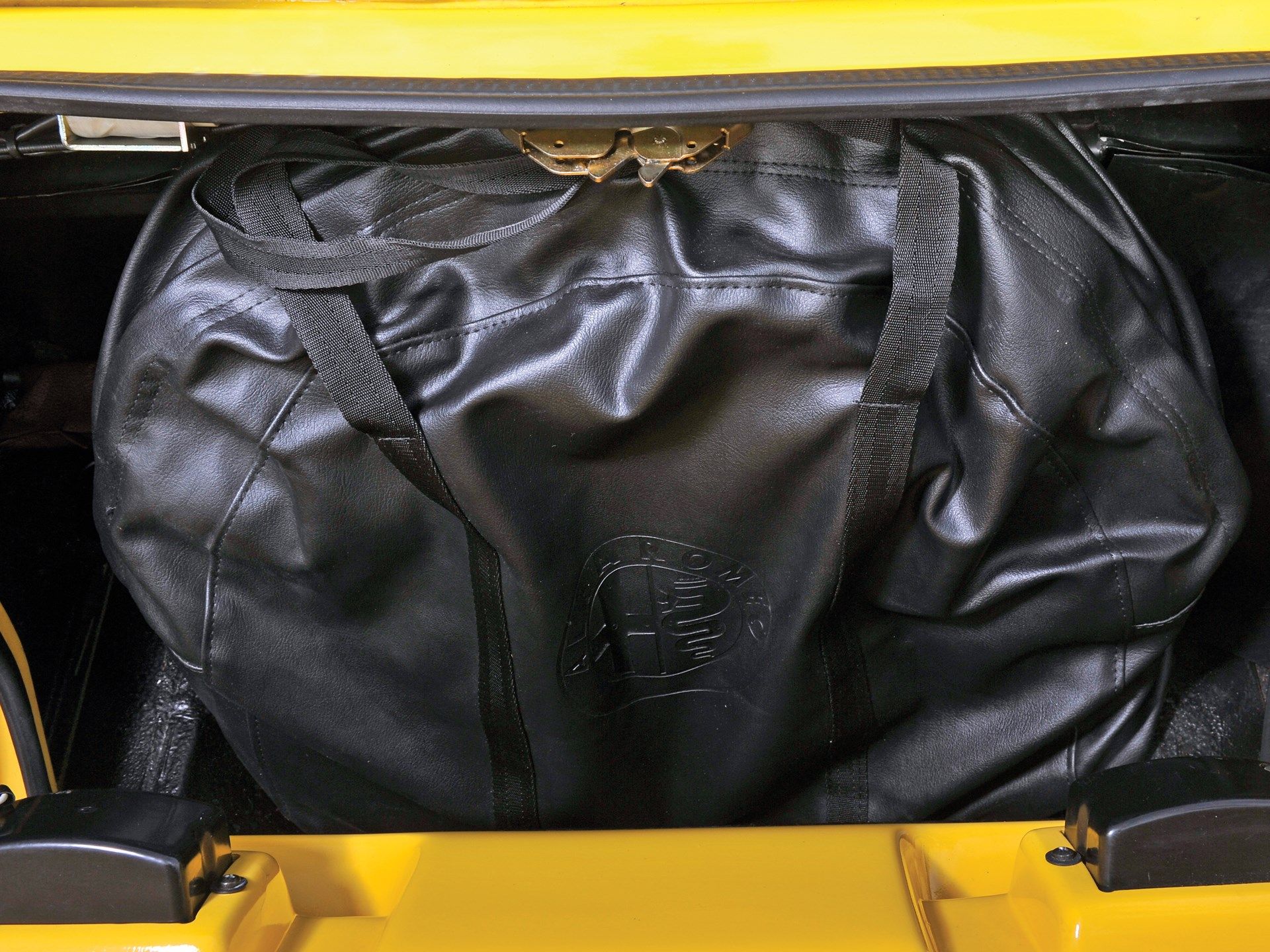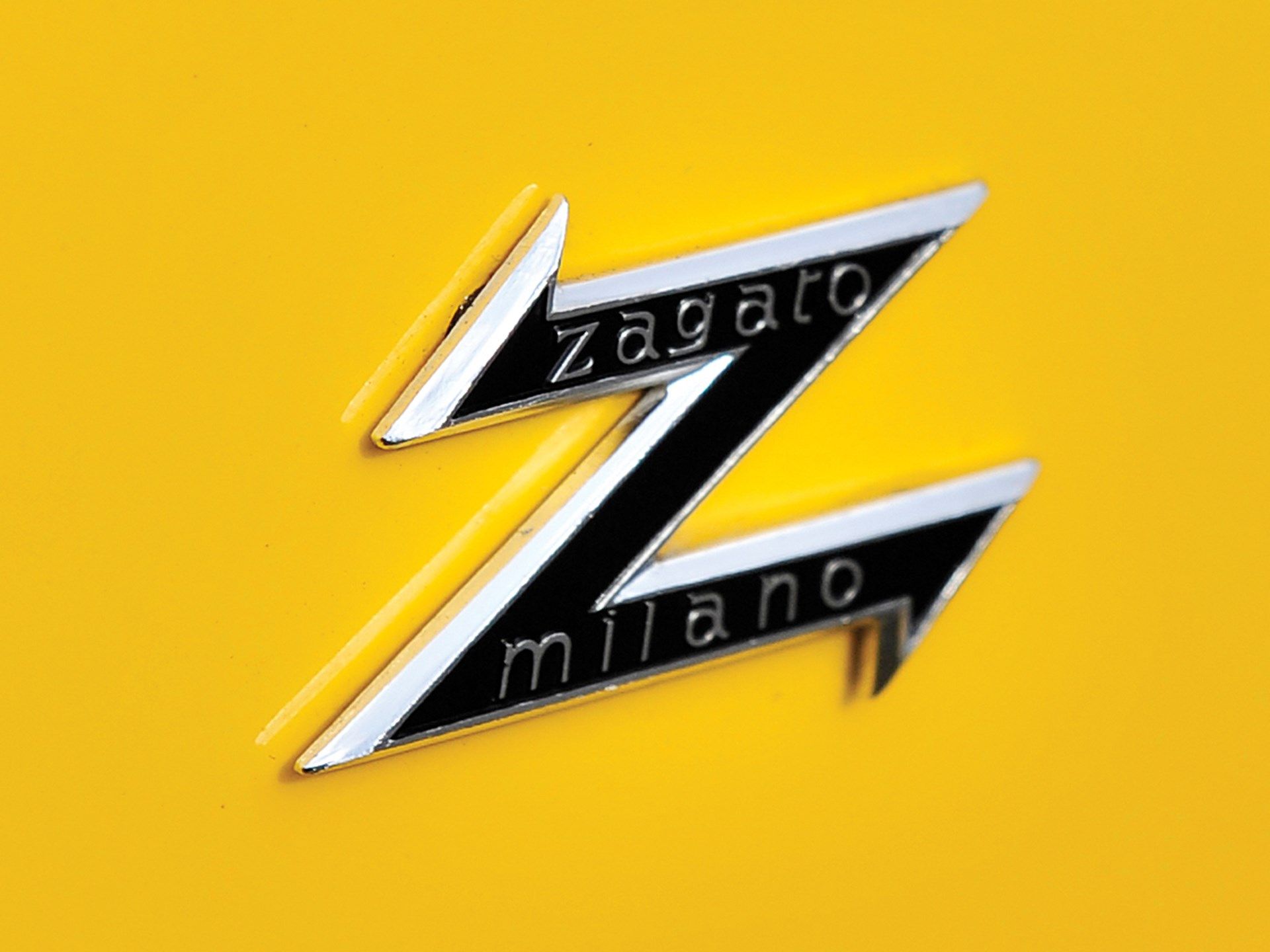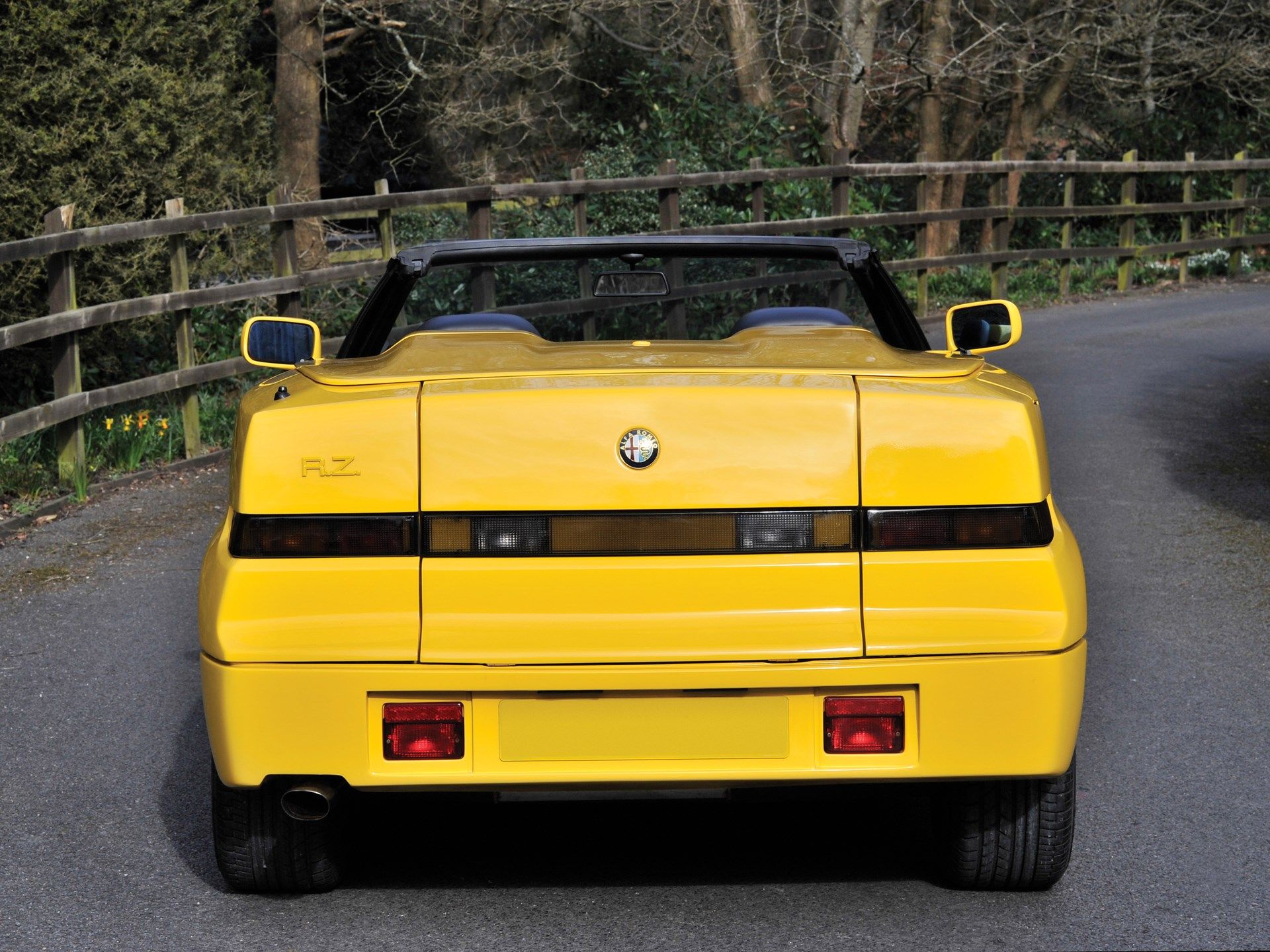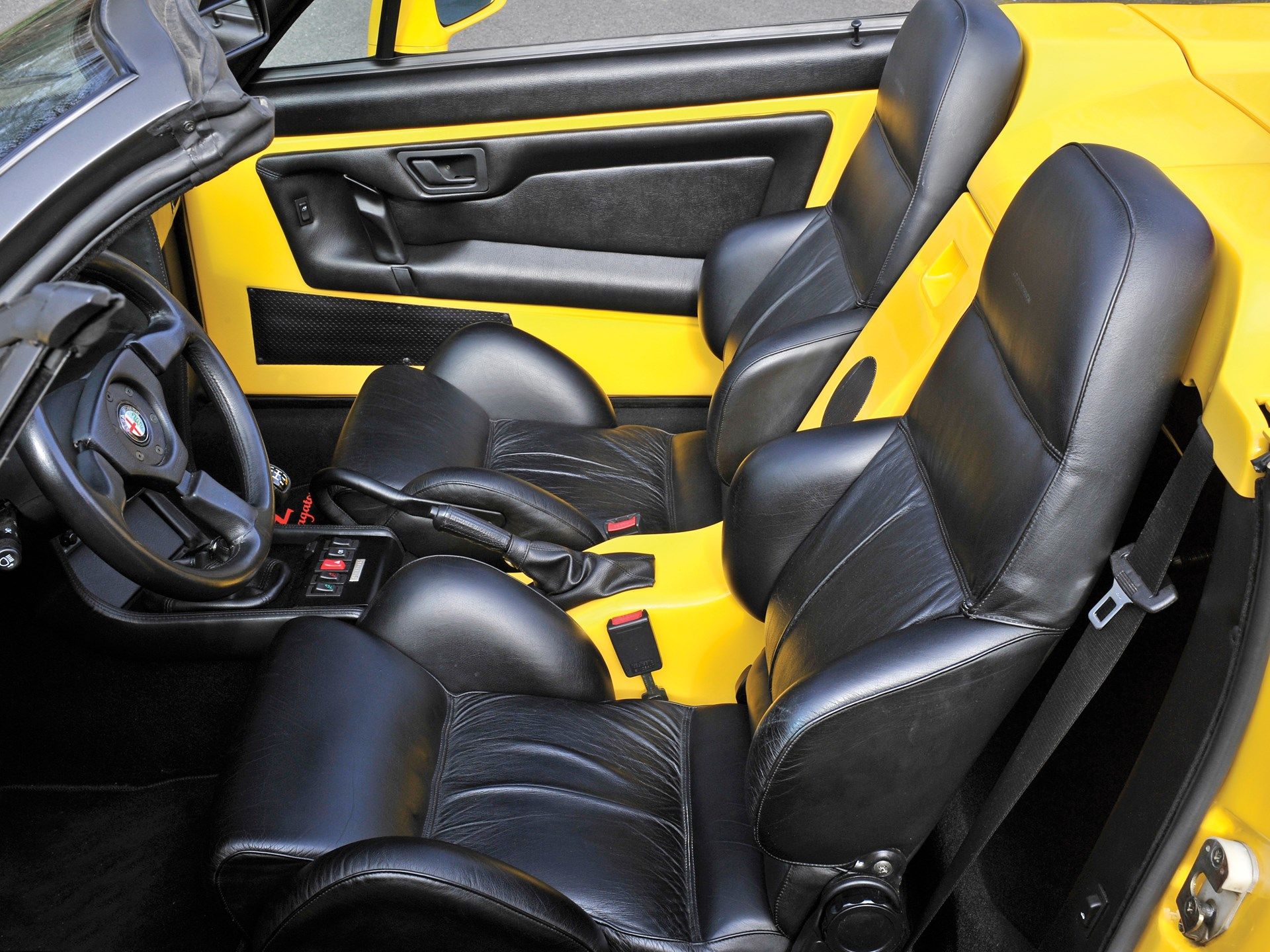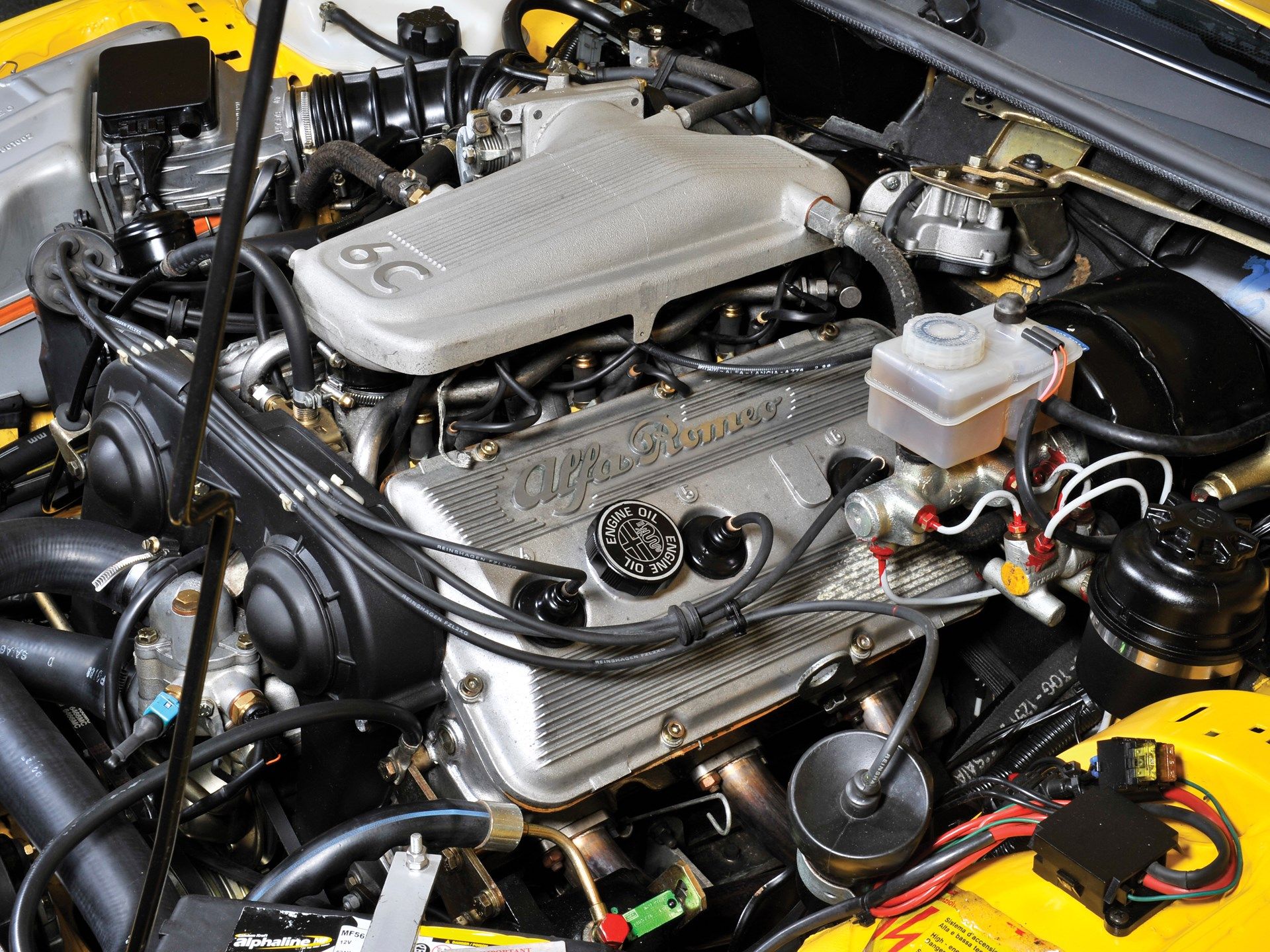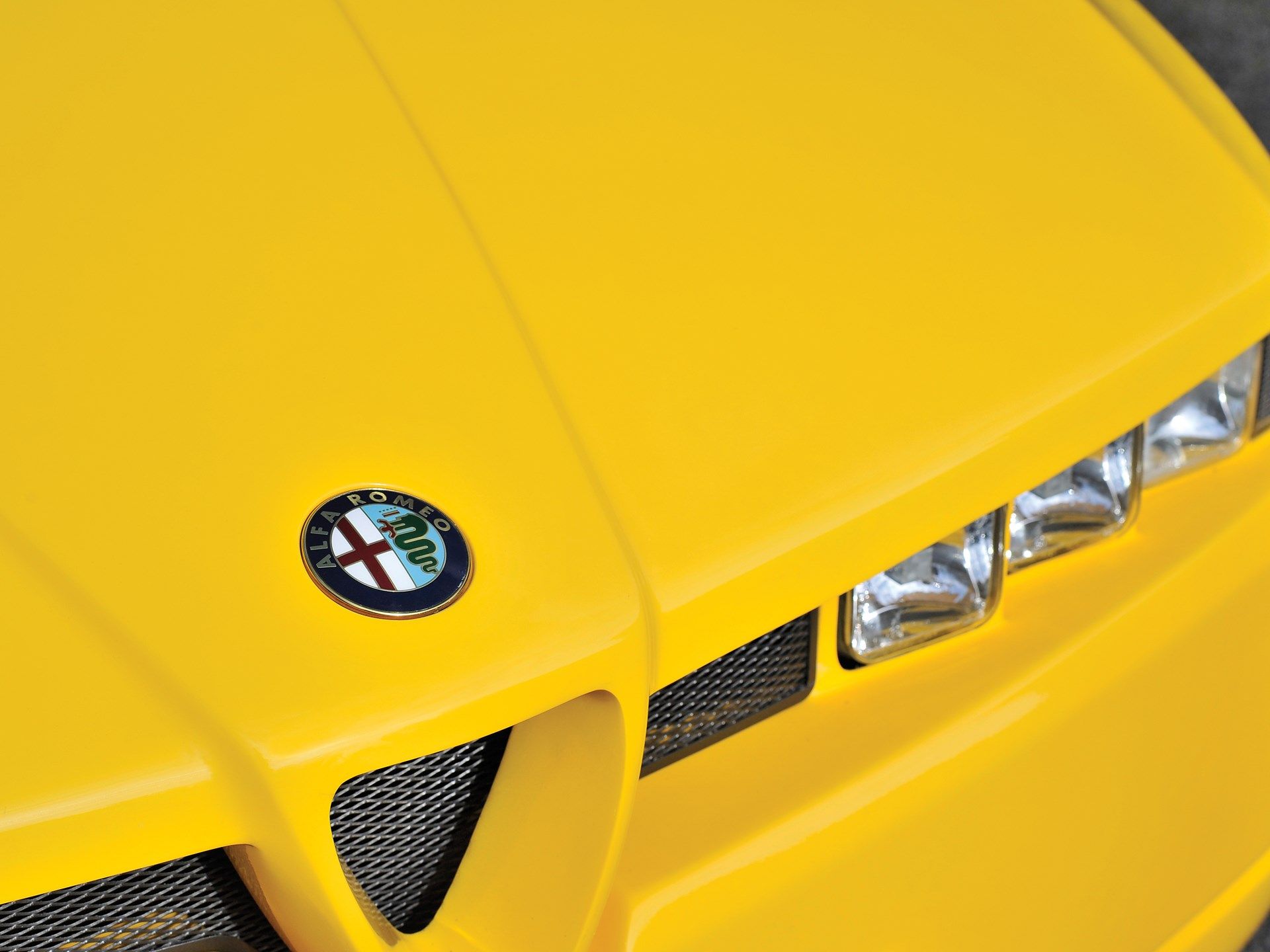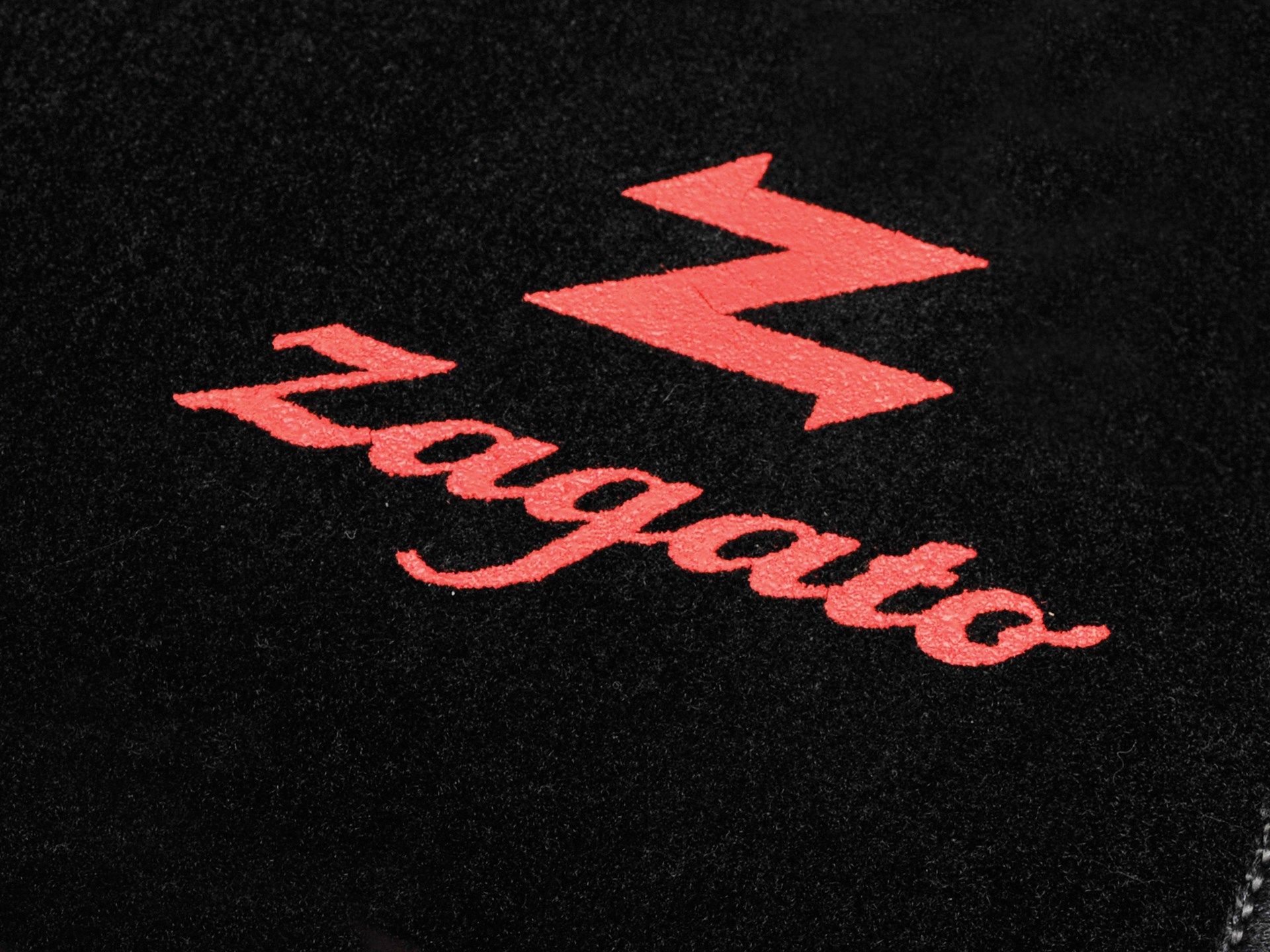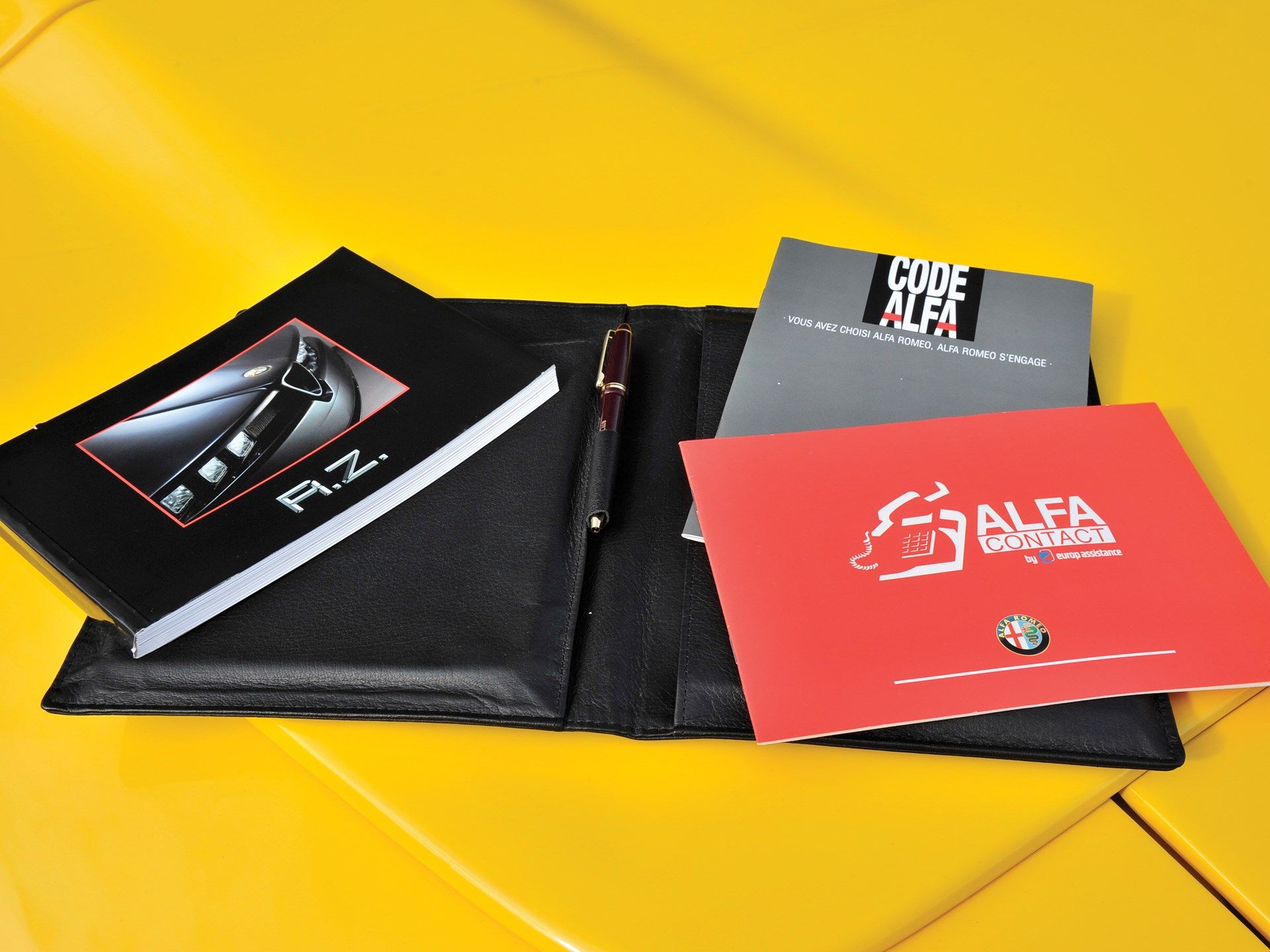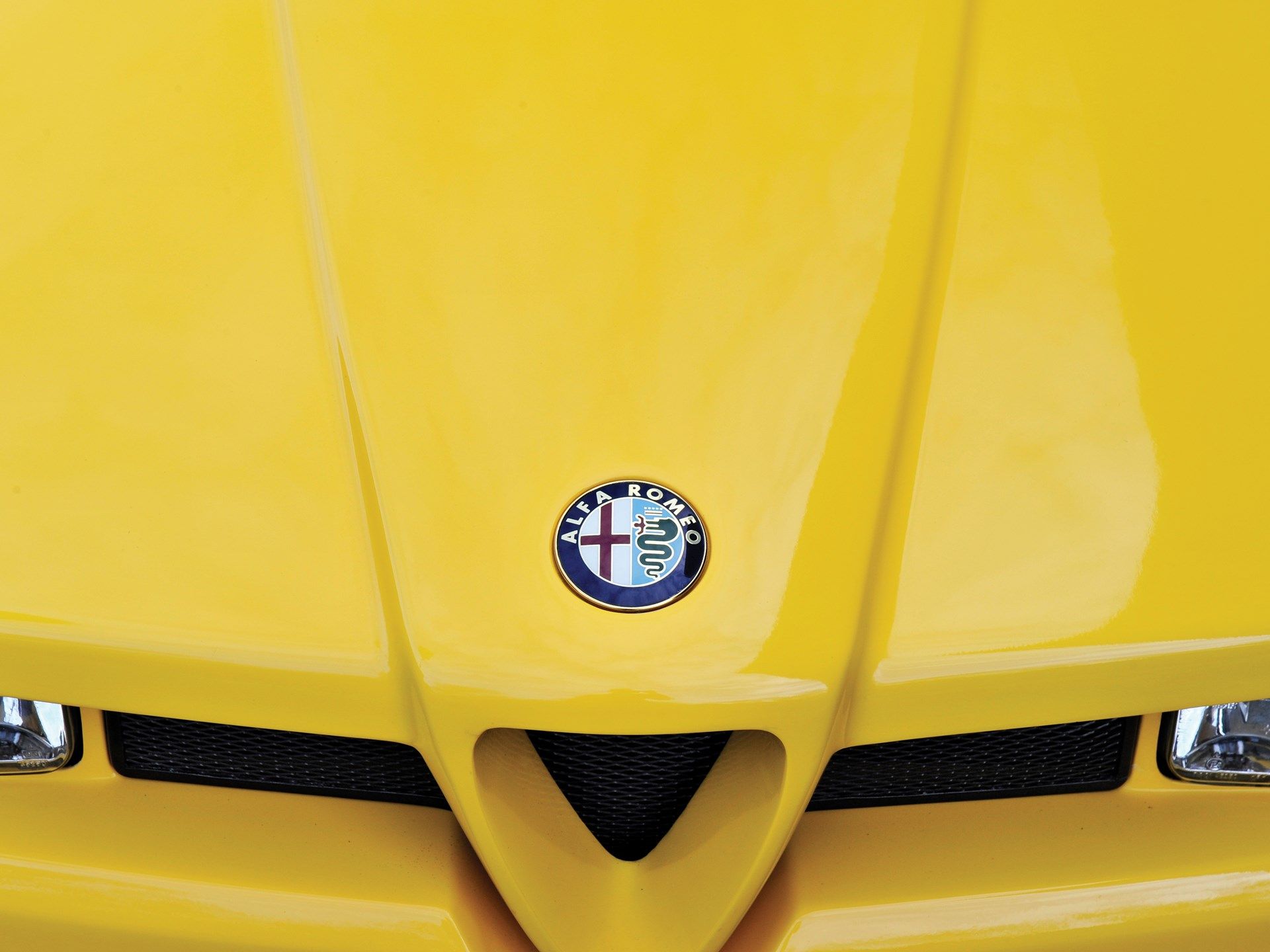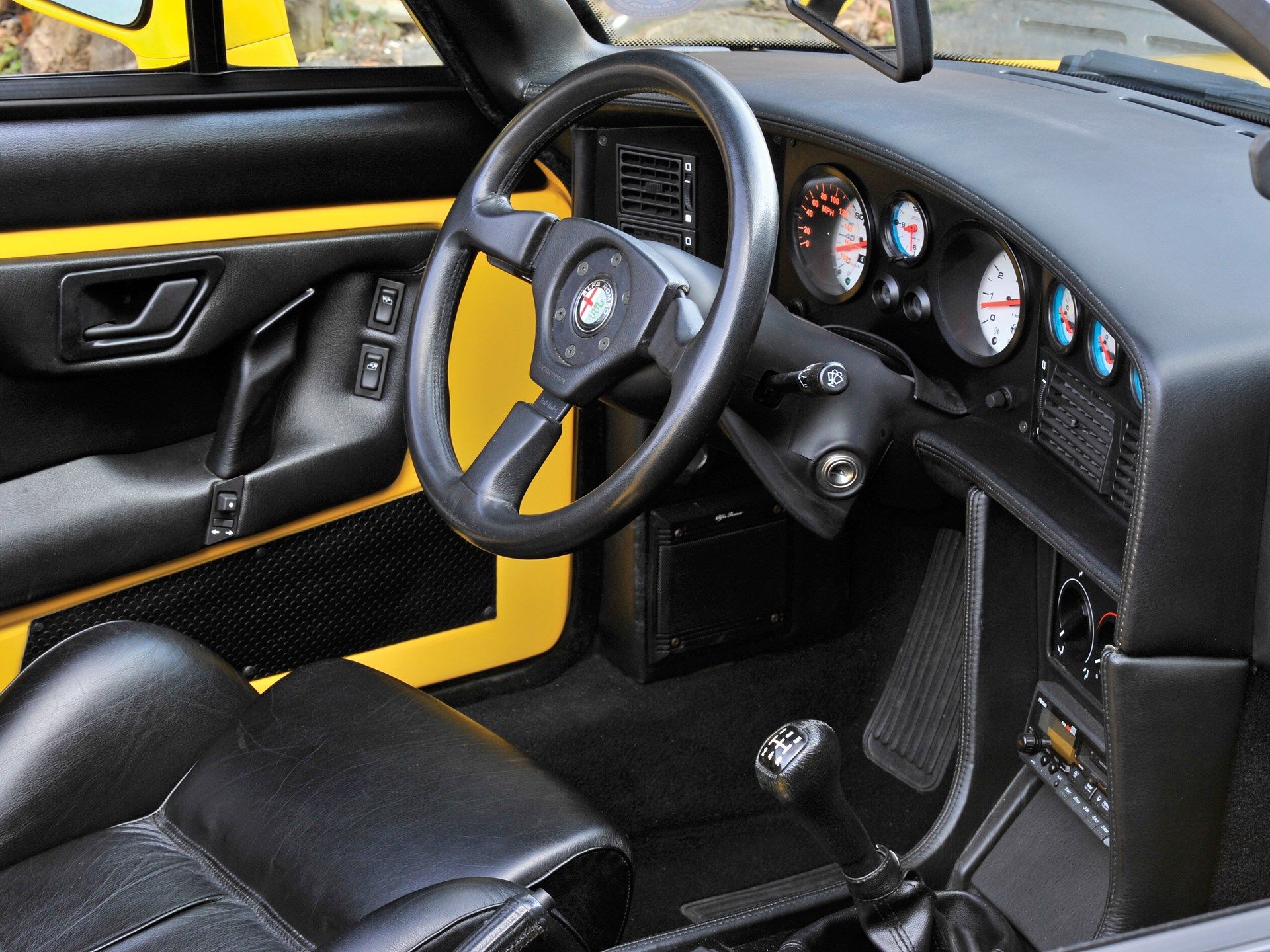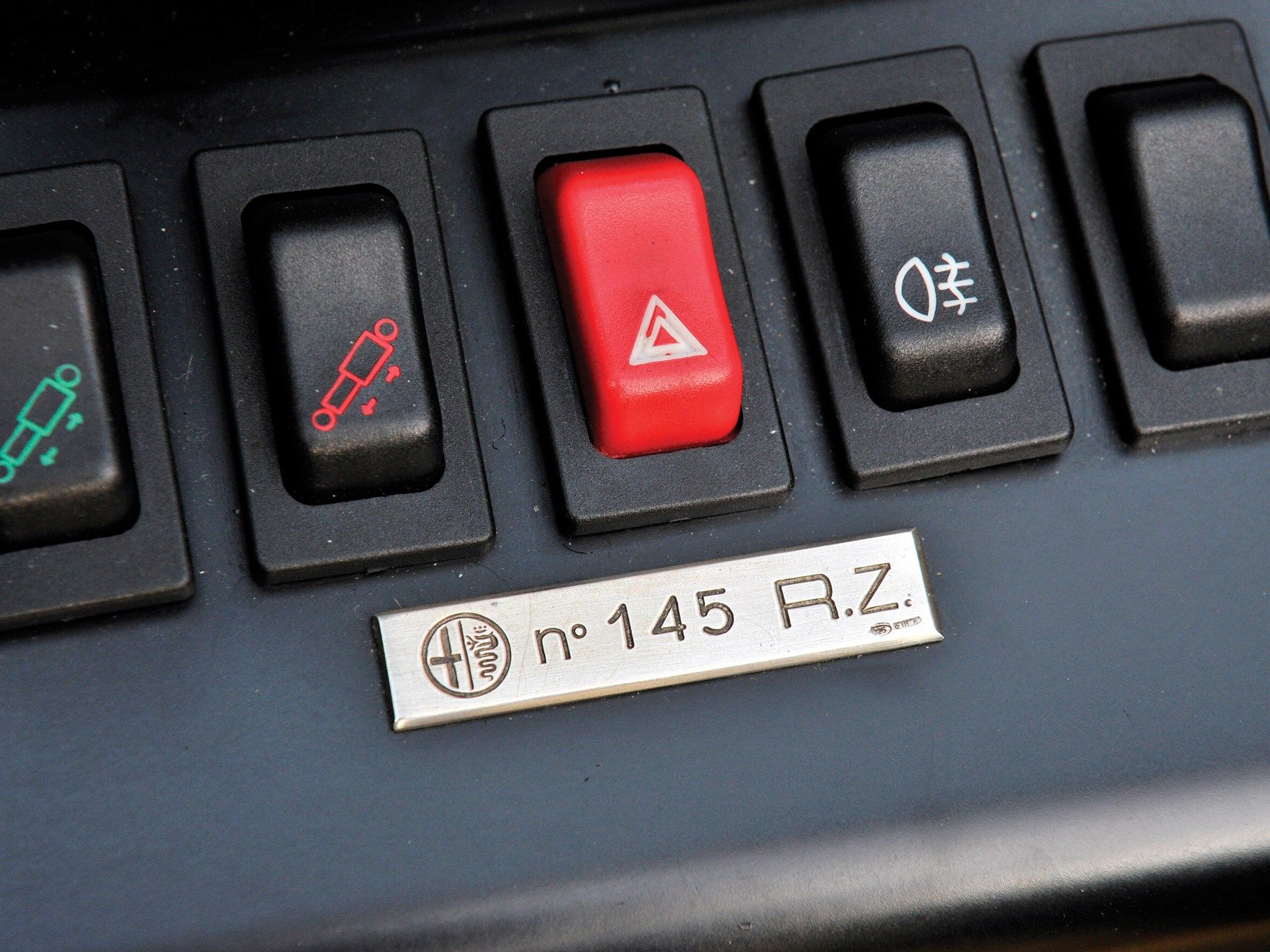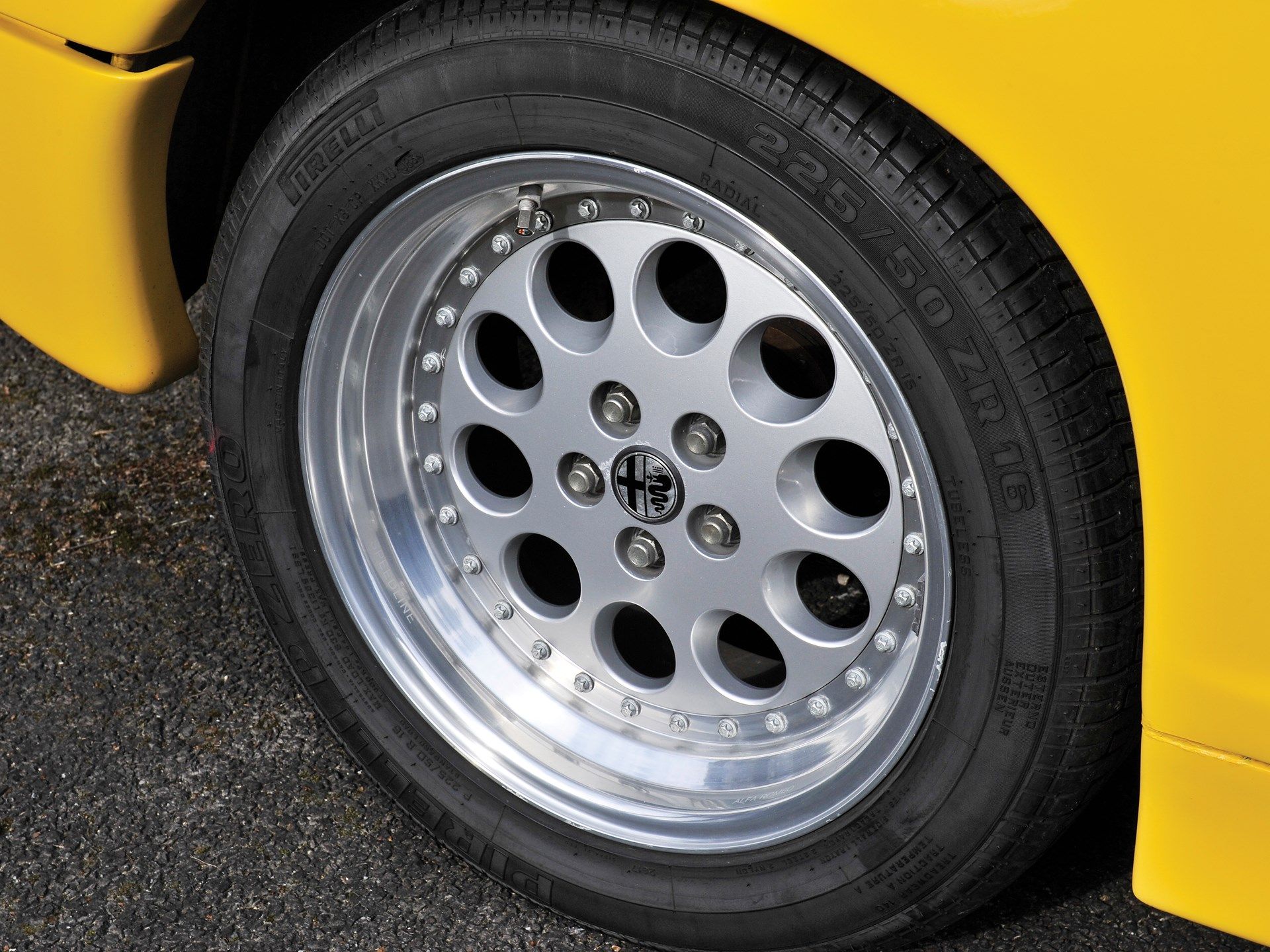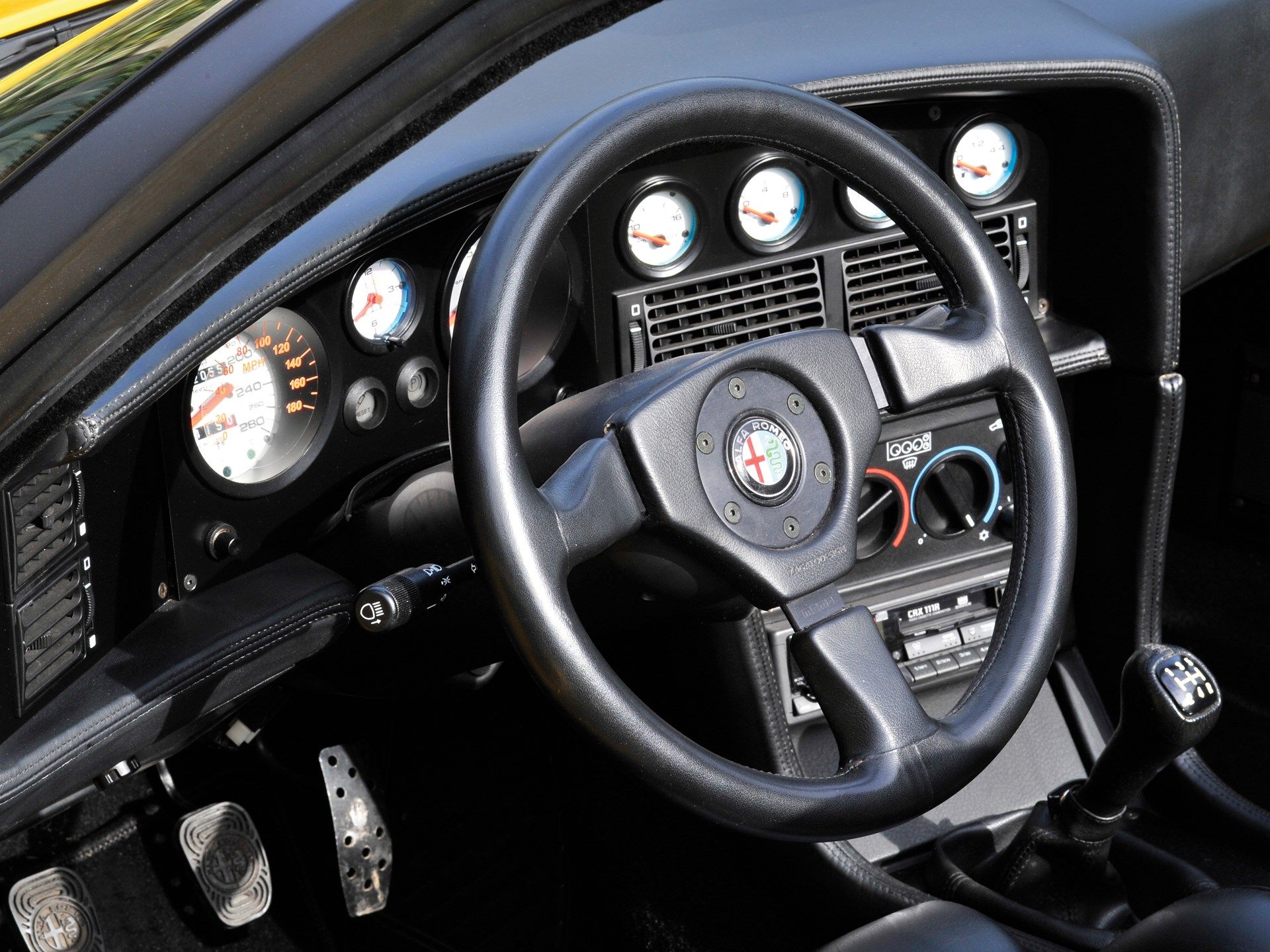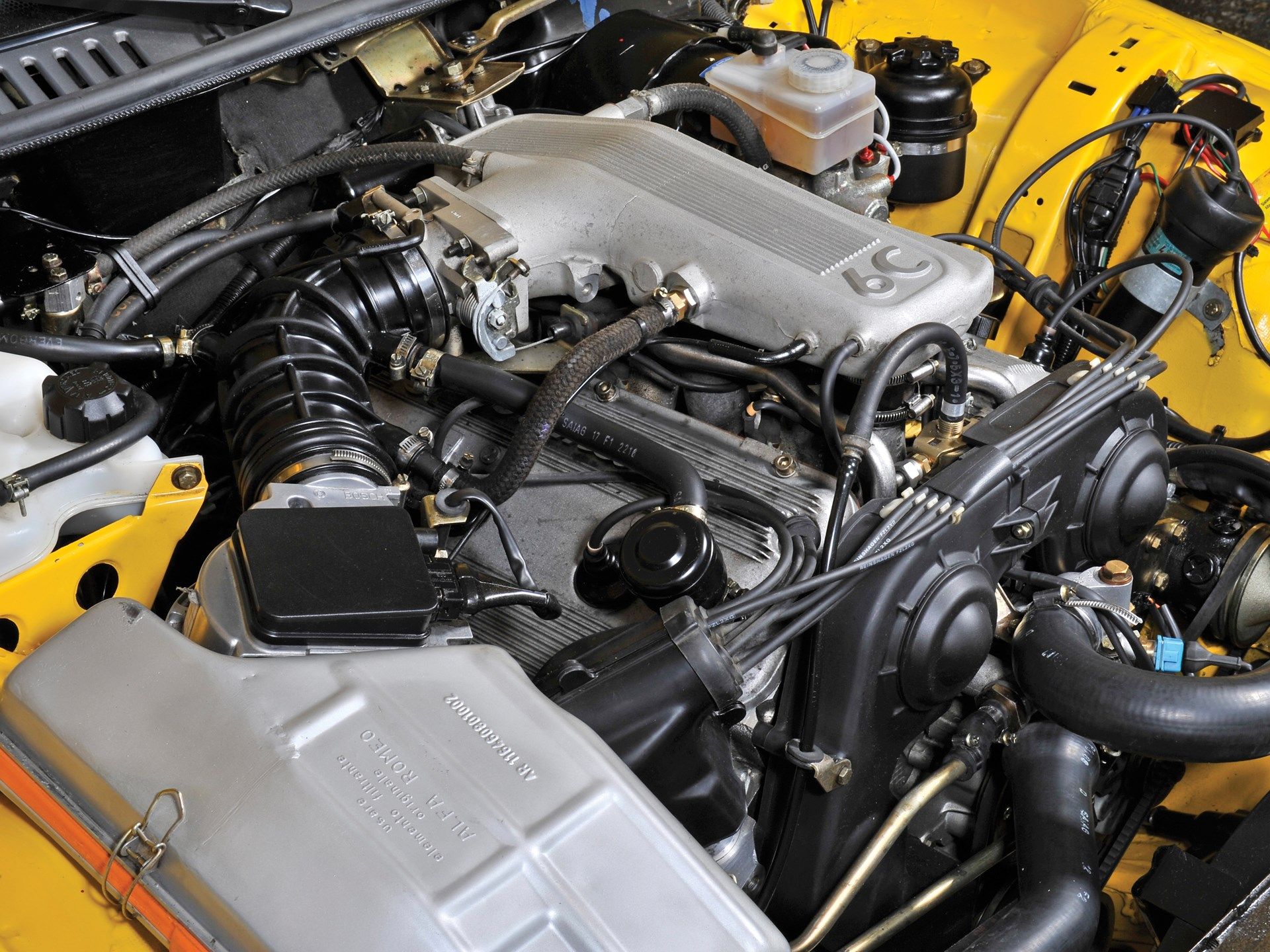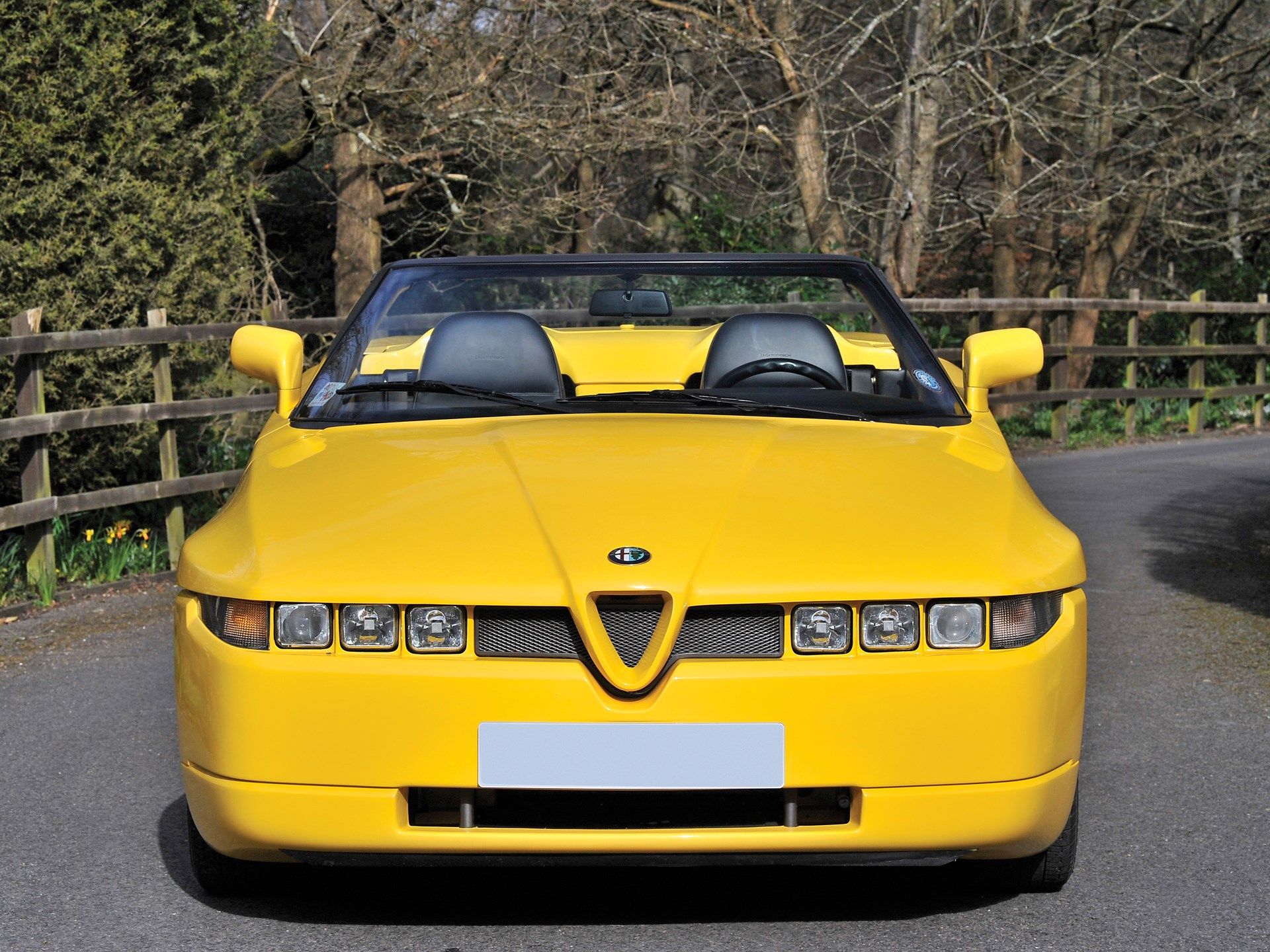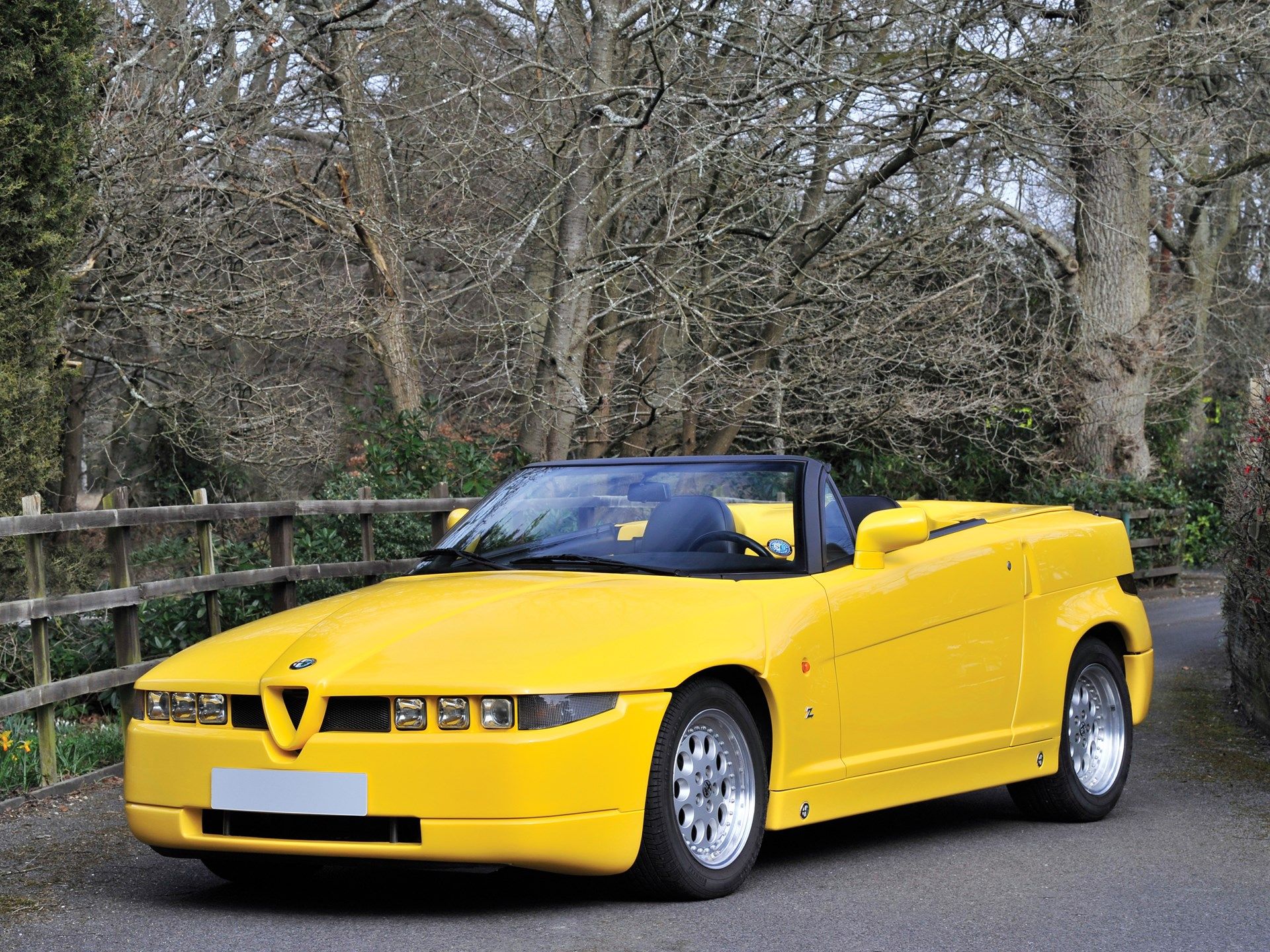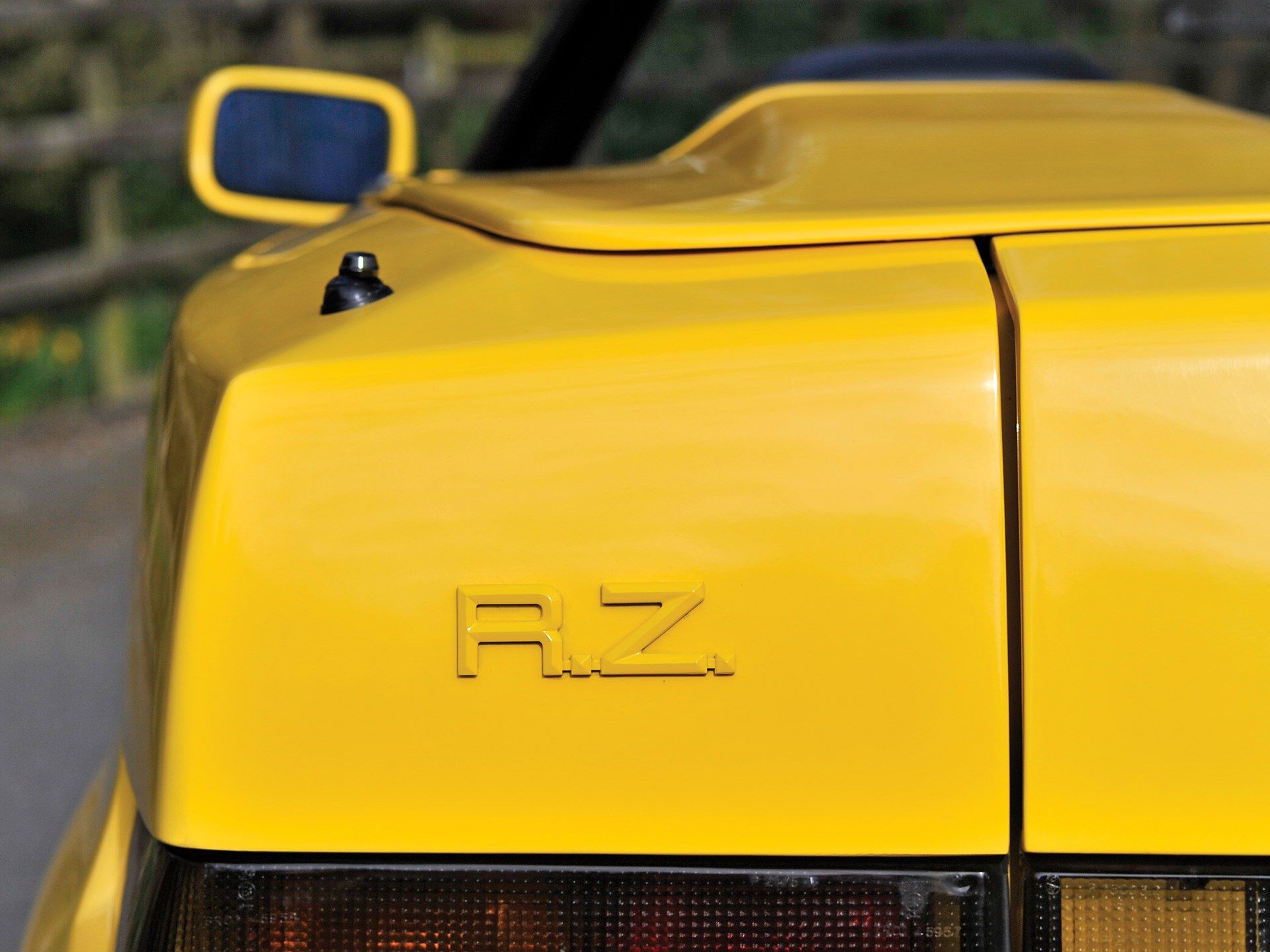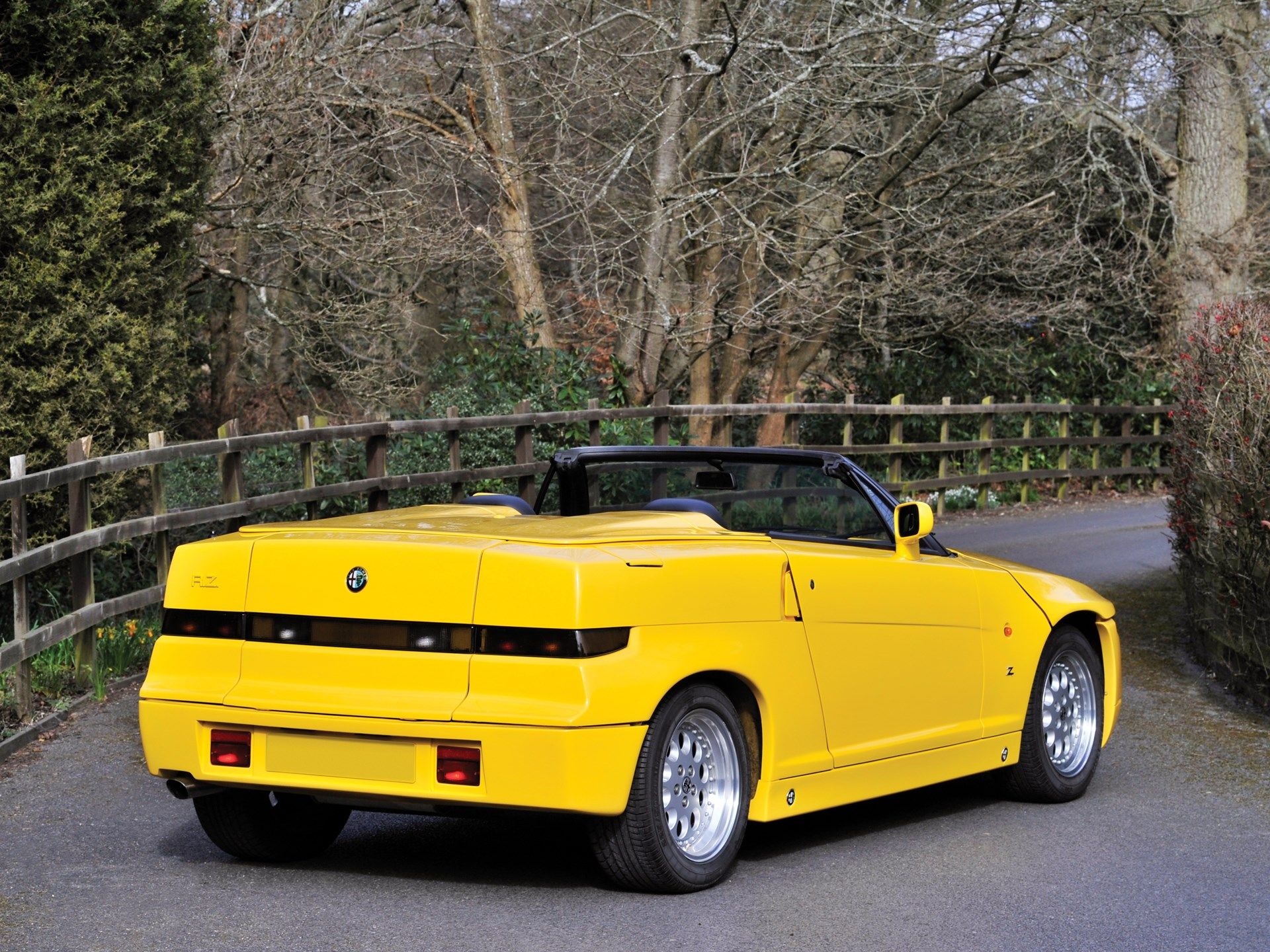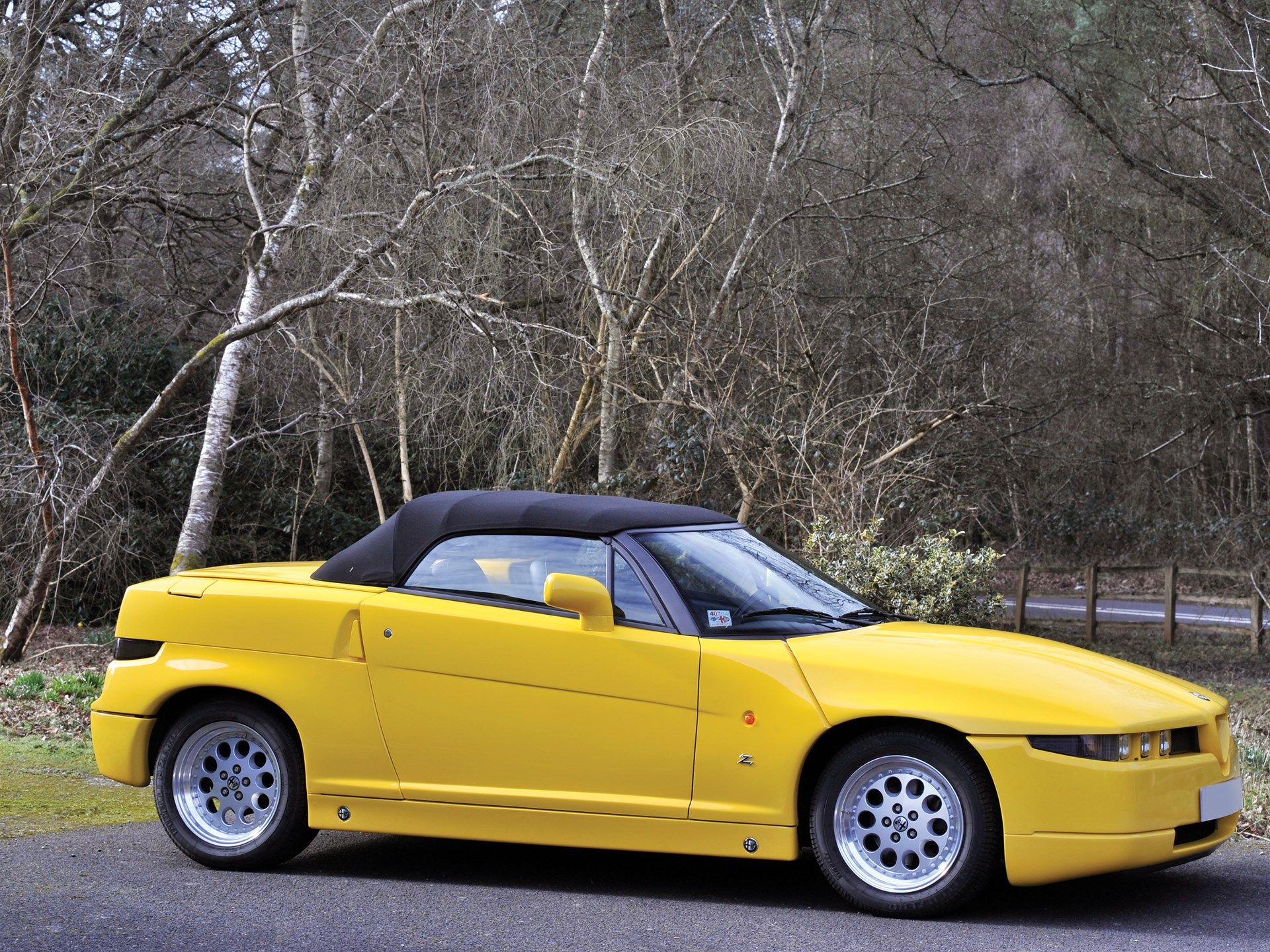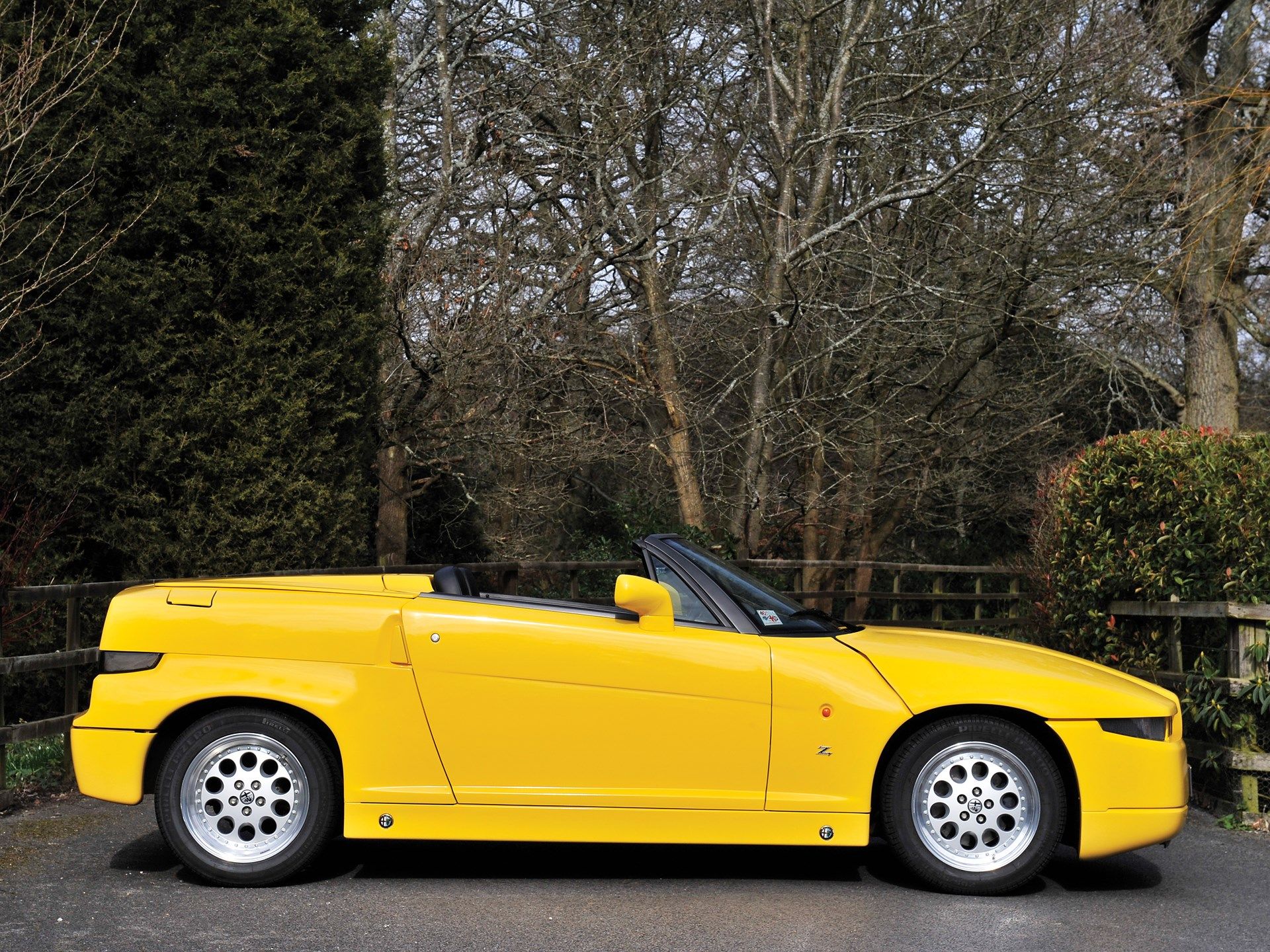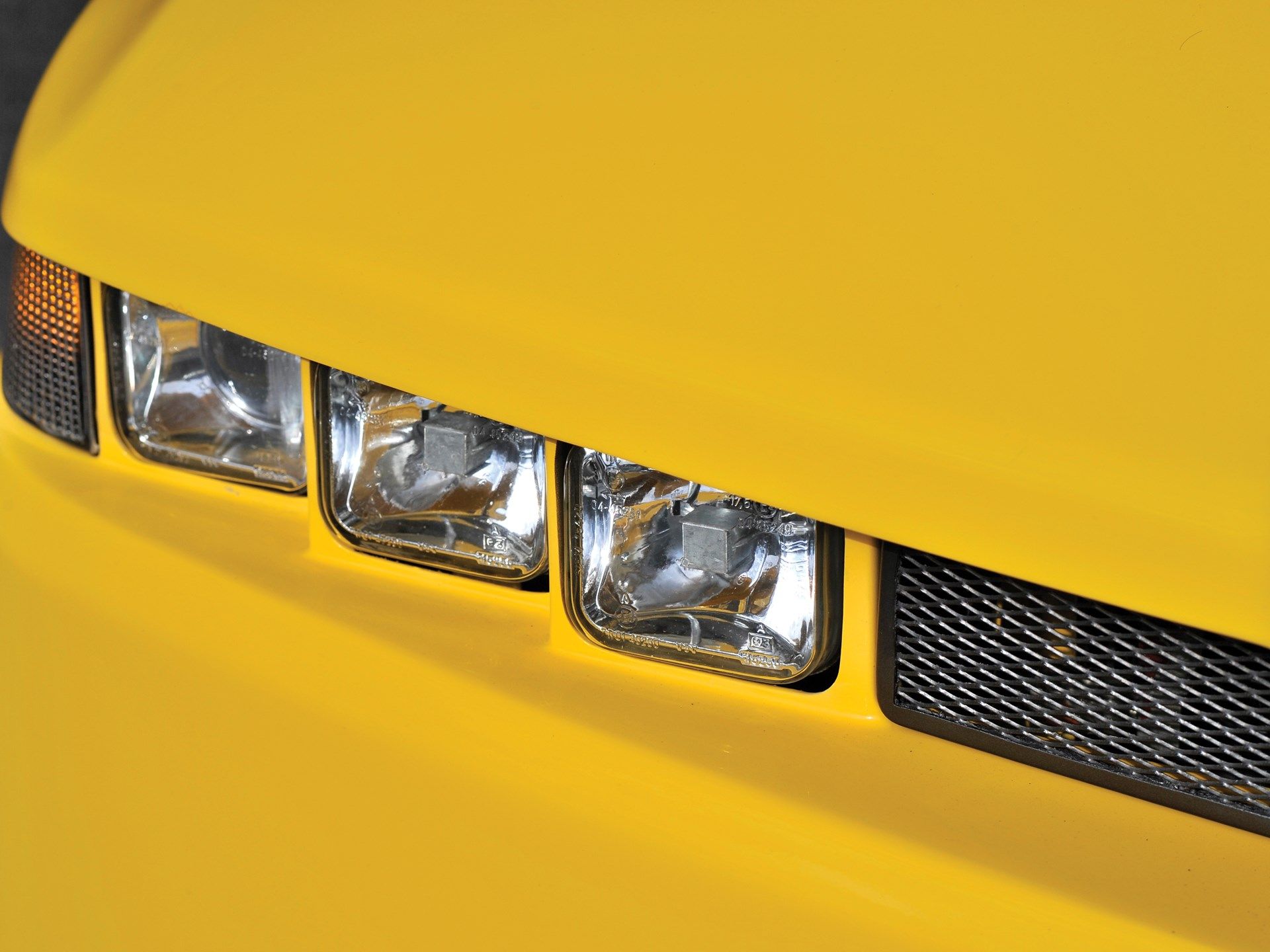The Alfa Romeo RZ is the equally-boxy and equally odd open-top version of the icon that is the SZ. Controversial at the time, the Zagato styling of the SZ/RZ family is now, 30 years on, considered downright legendary.
Produced as a limited-run joint project between Alfa Romeo and Fiat, the SZ Coupe and the RZ Roadster were laid on the underpinnings of the famed Alfa Romeo 75. Little over 1,000 SZs were built while the production cycle of the RZ began just after the final SZ was put together. Although the exact number varies depending on the source, no more than 285 Alfa Romeo RZ cars were ever built, making it much rarer than the already sought-after coupe.
The RZ was equipped with the same four-cam engine as the SZ although the lack of a solid roof makes the RZ the slower of the two. Alfa Romeo also chose to offer the SZ in more than one color combination, customers being offered the opportunity to pick their SZ up in either yellow or black, besides the customary red which was the only color available for the coupe. The last SZ rolled out of Zagato’s plant in Terrazzano di Rho in 1994 and, in spite of their popularity among the fans of the brand, the SZ and RZ aren’t particularly expensive to grab nowadays.
Keep reading to learn more about the odd Alfa Romeo RZ
1993 Alfa Romeo RZ by Zagato
- Make: Array
- Model: 1993 Alfa Romeo RZ by Zagato
- [do not use] Vehicle Model: Array
1993 Alfa Romeo RZ by Zagato Exterior
The design is the defining element of the Alfa Romeo RZ. The initial sketches were drafted by Robert Opron who was working at the time in the Fiat design studio. However, the car as we know it today was penned by Antonio Castellana and stands out due to the love-it-or-hate-it styling that’s very much Zagato in spirit while, also, unique to this car. It’s the peak of the boxy design language but, even back in 1989, many despised the abundance of 90-degree angles. In fact, it was nicknamed ”Il Mostro” at the time of its launch at the 1989 Geneva Auto Show.
It’s argued that Alfa Romeo used CAD renderings to design the car which could explain why it ended up with a virtually squared-off trunk, for instance. Back in the late ’80s, cars were still very much designed on the drawing board as computers were somewhat in their infancy. Still, some elements that pioneered on the SZ and RZ lived on and were borrowed by future Alfa Romeo models.
The body panels of the SZ were out of molded composite thermoplastic made by Carplast and Stratime Cappelo Systems from France. The body panels were then put on a chassis derived from that of the Alfa 75 race car. The same running gear and chassis were used on the RZ but, although the two look almost identical, they share only the front fenders and the trunk – although it lacks the spoiler on the RZ.
Also present is the opening between the hood line and the bumper itself where the headlights and indicators are placed. The triangular indicators sit on the edge of the front fascia while each of the six headlamps is positioned in a square box all to its own. The typical Alfa Romeo triangle extends downward as a continuation of the hood in a specifically-shaped cavity of the bumper.
Everything seems to fit rather poorly but, actually, big panel gaps are part of the aesthetic of the car. For example, the big gap between the hood and the front fenders is unmistakably SZ and is the same on the RZ.
The profile of the RZ has also been slightly altered compared to the coupe version. The door sills are slimmer, again to aid ground clearance. Otherwise, some RZs are fitted with dual Alfa Romeo logos on the skirts. The only Zagato logo on the car is located on the front quarter panel which is the starting point of a character line that goes all the way to the back of the car where it meets the straight bar-style taillights.
The gas cap is located on the upper edge of the car on an almost flat surface.
The Speedline 10-hole rims are a two-piece modular design. They came as the only option on both the SZ and the supposedly milder-looking RZ.
The back end of the RZ is similar to that of the SZ, minus the spoiler. You get the same darkened one-piece taillights and the trunk that opens downward. This is the only other element that’s shared with the SZ.
1993 Alfa Romeo RZ by Zagato Interior
The interior of the RZ is awash with leather and, while the car doesn’t lack creature comforts, you can see Alfa Romeo designed this car to be driven quite hard. The center console is angled towards the driver, something you’ll find if you step inside a BMW M3 E30 as well.
The three-spoke steering wheel sits in front of the tachometer and the odometer. Multiple other gauges are on the center console itself where you’ll also find the A/C vents, some other knobs, and the radio. The gear shifter sticks right out from the lower center console.
The yellow and red RZs came with black leather interior while the black ones had tan interior. There were also a few silver examples as well as a final RZ painted in white out of the final batch of cars that was put together in 1994.
1993 Alfa Romeo RZ by Zagato Drivetrain
The Alfa Romeo RZ shares the same engine with the SZ. The engine in question is the well-known ’Busso’ 3.0-liter naturally-aspirated V-6 mounted longitudinally. >
All that power was sent to the rear wheels through a five-speed transaxle. The coupe had a top speed of 150 mph and would reach 62 mph in under seven seconds. The roadster, however, was slower than that, but it’s never been about sheer performance when talking about the SZ or the RZ. The glorious sound from the naturally-aspirated Giuseppe Busso-designed engine is what makes the car great.
It also handled quite well thanks to the Gr. A-derived suspension and sub-2,900 pounds curb weight. The suspension itself was independent all-around with a De Dion rear axle with Watt’s linkage setup while the adjustable dampers were from Koni. It’s said that the SZ could pull 1.1 Gs at Alfa Romeo’s skidpad. Behind each of the 16-inch Speedline wheels were disc brakes. The rims themselves were shod with Pirelli P-Zero rubber.
The SZ was criminally over-priced when new. Adjusted for inflation, an SZ cost over $120,000 back in 1988. You couldn’t get a roadster for any less cash off the shelf either. Poor sales actually put Zagato, who built the cars, into receivership and caused the production of the RZs to cease after just 252 units were built. 32 more cars were built under the watchful eyes of the receivers before the production run finally came to a close.
All this means that, while a bit of an icon in the Alfa circles, the RZ actually depreciated with the passing of time. The E30 was roughly $50,000 cheaper than the SZ and RZ when new. For being a more thrifty individual, you got an all-around better car, in short. Yes, the Alfa V-6 has a sound that no four-pot could ever hope to match but, in the same way, the Bimmer can’t match the Alfa in terms of auditory pleasure, the SZ and RZ are left in the dust of the M3 on any given piece of tarmac. Yes, they both weigh about the same, early M3s being actually heavier than the Alfa Romeo, but the coupe from Munich is a much stiffer car.
You’d think that will all that racing DNA, the SZ would fair better against the touring car legend that is the M3, but it doesn’t. And you’ll also find many more people agreeing with your style if you arrive in an M3 than in an SZ or RZ. But, maybe, that’s the flair of the Alfa: to devise opinions even 30 years since its launch.
Read our full review on the BMW M3 E30
It’s easy to find flaws with the RZ and its fixed-head brother, but you can also fall in love with one just as easily. Go past the flurry of straight edges and deep creases, the sometimes dubious build quality and arguably underpowered engine. Because of the pleasure of the SZ, the last to revive the Sport Zagato nameplate that became famous in the ’60s is one of the few truly legendary cars of the late ’80s and early ’90s and that’s due to its charm.
A charm that was built on hordes of people arguing about its styling, people applauding that gorgeous engine under the hood and people admitting that, after a while, it grows on you. So let the RZ grow on you!
Read our full review on the 1962 Alfa Romeo Giulietta Sprint Zagato "Coda Tronca."
1993 Alfa Romeo RZ by Zagato Pricing
1993 Alfa Romeo RZ by Zagato Competition
BMW M3 E30
Final Thoughts
Further reading

